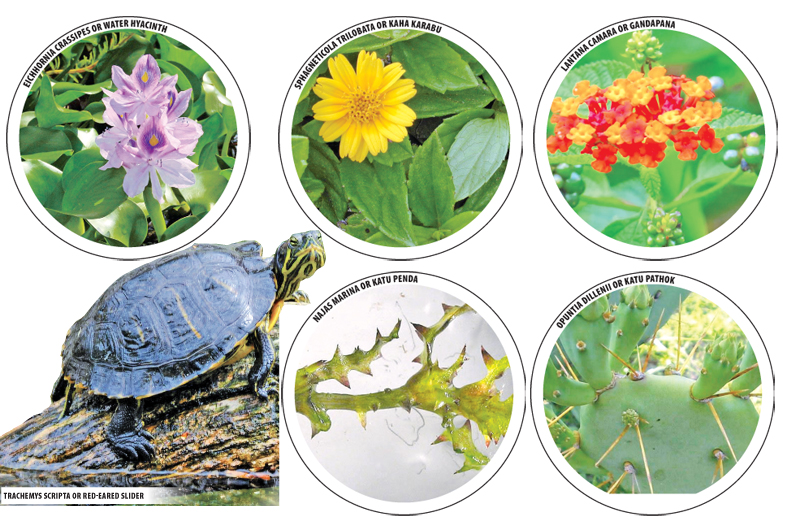As a direct result of Invasive Alien Species (IAS), the depletion of unique biodiversity has affected Sri Lanka in numerous ways. Invasive Alien Species of Flora and Fauna have already caused irreparable damage in the spheres of Agriculture, Fisheries Industry and Tourism Industry of Sri Lanka. This article explores the most common IASs in the country and their areas of impact. Action taken to control the issue however, remains woefully inadequate despite the numerous impacts it has caused to agriculture and natural ecosystems.
 INTRODUCTION OF ALIEN INVASIVE SPECIES:
INTRODUCTION OF ALIEN INVASIVE SPECIES:
The Water Hyacinth
One of the worst Invasive Alien Aquatic Plant Species found in Sri Lanka is the ‘Water Hyacinth’ (Eichhornia crassipes). It is a native plant species of South America having beautiful, large purple and violet flowers. It is a very popular ornamental plant for ponds. Water Hyacinth (Japan Jabara) however has been identified as one of the worst aquatic weeds in the world. It is now found in 50 countries on five continents. It is a fast growing plant with the population known to double in only 12 days.
It affects water ways, boat traffic, swimming and fishing. In addition this aquatic invasive plant prevents sunlight and oxygen from reaching the water column and submerged plants.
It is believed that the wife of the British Colonial Governor, Lady Blake had brought Water Hyacinth to Sri Lanka as an ornamental plant in 1901. She had obtained the assistance of the Peradeniya Botanical Garden in planting the seeds of Water Hyacinth. It was thereafter seen to spread fast across all the major water ways across Sri Lanka.
‘Kaha Karabu’ (Sphagneticola trilobata)
It has been identified as one of the World’s 100 worst Invasive Alien Species introduced to Asia from the tropics of Central South America. It was introduced to Sri Lanka as a cover crop in 1980 to tea plantations from India. In Sri Lanka, this invasive plant is found spreading across the country even in paddy lands.
Lantana Camara (Gandapana):
According to a survey of the Environmental Scientist, Craig Walter IUCN Specialist Group, QueenslandAustralia, there are 650 varieties found over 60 countries across the world. It affects agriculture and natural ecosystems. This Invasive Alien Plant Species found all over Sri Lanka has the power to reduce the growth of plants nearby and reduce production. It had been grown since the 16th century in Europe for horticultural purposes. Lantana secretes toxic chemicals to the soil.
Giant Mimosa (Mimosa pigra)
Mimosa Pigra has been identified as one of the worst 100 species of plants in the world according to the Global Invasive Species Data Bank of the Invasive Specialist Group. Brazil is the native country of this Invasive Alien Species. It has spread throughout Sri Lanka especially on the banks of the Mahaweli River and absorbs the nutrients of the soil affecting other plant species.
Najas Marina (Katu Penda)
The emergence of Invasive Alien Species of aquatic plant known as Najas marina in the Madu River estuary has already caused great damage to the biodiversity of the Madu River in Balapitiya.
The former head of the Biodiversity Section of the Country Office of IUCN, Colombo Dr. Channa Bambaradeniya addressing the media briefing revealed the gravity of the damage caused by Najas marina to the Ramsar Wetland of Bundala - the impacts have been immense and irreparable. All stakeholders living on the resources of Madu River have been affected by this invasive aquatic plant. In 1998, the Wetland Site Report of Madu River at Balapitiya was completed by the Central Environmental Authority and together with the research findings of IUCN on Madu River, it was revealed that the Madu River Wetland comprised of 10 major wetland vegetation types and out of a total number of 303 species - 19 species were identified as endemic and eight species were known to be threatened.
The latest threat to the river is the construction of over 10 ornamental fish tanks full of alien fish species in the middle of the Madu River for the purpose of providing people with a ‘Fish Massage’. Environmentalists both foreign and local were shocked to see alien fish tanks in the Madu River violating the rules and regulations of the Ramsar Wetland Convention.
When these Alien Fish Species escape to the river during heavy floods, the endemic fish, shrimp and crabs species are likely to end up prey to these alien fish. Environmental Authorities have so far not taken any action to remove these Alien Fish Tanks.
Katu Andara (Prosopis Juliiflora)
This is a native plant of Central and South America and it has been introduced to Africa, Asia and Australia. In 1880, this invasive species had been introduced to Sri Lanka as a plant which would provide shade and to prevent erosion.
Bundala National Park; a Ramsar Wetland and Wilpattu National Park in the country had been invaded by Katu Andara and Katu Pathok (Opuntia dillenii). The fruits of Opuntia dillenii or Katu Pathok are eaten by monkeys while feral buffaloes and cattle feed on the leaves of Prosopis juliiflora (Katu Andara ) and thus disperse the seeds of the plant through the dung.
Dr. Bambaradeniya, an expert on the Invasive Alien Species of Flora and Fauna of Sri Lanka once said that there were 38 species of invasive alien plants and 20 species of alien animals in Sri Lanka.



Add new comment